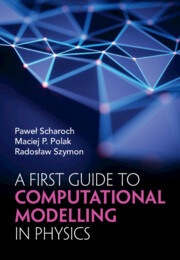Book contents
- Frontmatter
- Contents
- Preface
- How to Use the Book
- First Steps
- Project 1: Rectangular Finite Quantum Well – Stationary Schrödinger Equation in 1D
- Project 2: Diffraction of Light on a Slit
- Project 3: Pendulum as a Standard of the Unit of Time
- Project 4: Planetary System
- Project 5: Gravitation inside a Star
- Project 6: Normal Modes in a Cylindrical Waveguide
- Project 7: Thermal Insulation Properties of a Wall
- Project 8: Cylindrical Capacitor
- Advanced Projects
- Project 9: Coupled Harmonic Oscillators
- Project 10: The Fermi–Pasta–Ulam–Tsingou Problem
- Project 11: Hydrogen Star
- Project 12: Rectangular Quantum Well Filled with Electrons – The Idea of Self-Consistent Calculations
- Project 13: Time Dependent Schrödinger Equation
- Project 14: Poisson’s Equation in 2D
- Appendix A: Supplementary Materials
- Further Reading
- Index
Project 9: - Coupled Harmonic Oscillators
Published online by Cambridge University Press: 01 February 2024
- Frontmatter
- Contents
- Preface
- How to Use the Book
- First Steps
- Project 1: Rectangular Finite Quantum Well – Stationary Schrödinger Equation in 1D
- Project 2: Diffraction of Light on a Slit
- Project 3: Pendulum as a Standard of the Unit of Time
- Project 4: Planetary System
- Project 5: Gravitation inside a Star
- Project 6: Normal Modes in a Cylindrical Waveguide
- Project 7: Thermal Insulation Properties of a Wall
- Project 8: Cylindrical Capacitor
- Advanced Projects
- Project 9: Coupled Harmonic Oscillators
- Project 10: The Fermi–Pasta–Ulam–Tsingou Problem
- Project 11: Hydrogen Star
- Project 12: Rectangular Quantum Well Filled with Electrons – The Idea of Self-Consistent Calculations
- Project 13: Time Dependent Schrödinger Equation
- Project 14: Poisson’s Equation in 2D
- Appendix A: Supplementary Materials
- Further Reading
- Index
Summary
This project explores the phenomenon of coupled harmonic oscillators, which have a broad relevance in fields such as mechanics, atomic and quantum physics, optics, electronics, and biology. The paper expands on a model of a harmonic oscillator, using numerical methods for solving differential equations to analyse systems of coupled oscillators. The study focuses on two illustrative cases: a one-dimensional system of two point masses suspended from springs, and a system of two simple pendulums moving in the same plane. The derived mathematical equations of motion provide a comprehensive framework for understanding the behaviour of such systems. Through computational experimentation, the project aims to elucidate the oscillatory behaviour of these systems depending on different parameters and their coupling, particularly focusing on energy transfer between the oscillators. The Runge–Kutta algorithm is employed for solving the initial value problem (IVP) for the ordinary differential equations (ODE) governing these systems. The project underscores the versatility of the harmonic oscillator model by showing that different physical systems can be described by the same mathematical model.
Keywords
- Type
- Chapter
- Information
- A First Guide to Computational Modelling in Physics , pp. 58 - 63Publisher: Cambridge University PressPrint publication year: 2024



